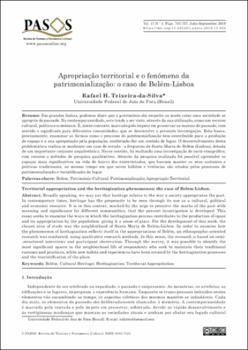Apropriação territorial e o fenómeno da patrimonialização: o caso de Belém‑Lisboa
Fecha
2019Resumen
Em grandes linhas, podemos dizer que o patrimônio diz respeito ao modo como uma sociedade se apropria do passado. Na contemporaneidade, este tende a ser visto, através da sua utilização, como um recurso cultural, político e econômico. É, neste contexto, marcado pelo ímpeto em preservar as marcas do passado, com
sentido e significado para diferentes comunidades, que se desenvolve a presente investigação. Esta busca, precisamente, examinar as formas como o processo de patrimonialização tem contribuído para a produção do espaço e a sua apropriação pela população, conferindo‑lhe um sentido de lugar. O desenvolvimento desta
problemática realiza‑se mediante um caso de estudo ‑ a freguesia de Santa Maria de Belém (Lisboa), dotada de um importante conjunto arquitetônico. Nesse sentido, foi realizada uma investigação de cariz etnográfico, com recurso a métodos de pesquisa qualitativos. Através da pesquisa realizada foi possível apreender os espaços mais significativos na vida de bairro dos entrevistados, que buscam manter os seus costumes e práticas tradicionais, ao mesmo tempo em que novos hábitos e vivências são criados pelos processos de patrimonialização e turistificação do lugar. Broadly speaking, we may say that heritage relates to the way a society appropriates the past.
In contemporary times, heritage has the propensity to be seen through its use as a cultural, political
and economic resource. It is in this context, marked by the urge to preserve the marks of the past with
meaning and significance for different communities, that the present investigation is developed. This
essay seeks to examine the ways in which the heritagization process contributes to the production of space
and its appropriation by the population, giving it a sense of place. For the development of this work, the
chosen area of study was the neighborhood of Santa Maria de Belém‑Lisbon. In order to examine how
the phenomenon of heritagization reflects itself in the appropriations of Belém, an ethnographic‑oriented
research was conducted, using qualitative research methods. In this sense, the research is based on semi‑
‑structured interviews and participant observation. Through the survey, it was possible to identify the
most significant spaces in the neighborhood life of respondents who seek to maintain their traditional
customs and practices, while new habits and experiences have been created by the heritagization processes
and the touristification of the place





